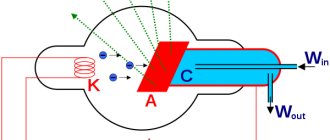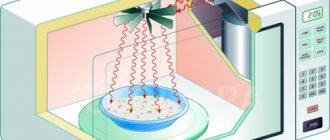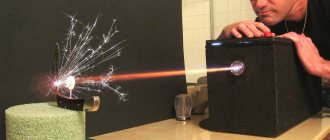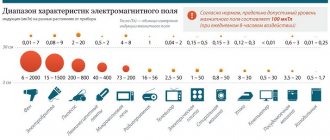microwave radiation
Among the huge variety of electromagnetic waves existing in nature, microwave or microwave radiation (microwave) occupies a very modest place. This frequency range can be found between radio waves and the infrared part of the spectrum. Its length is not particularly great. These are waves with a length of 30 cm to 1 mm.
Let's talk about its origin, properties and role in the human environment, about how this “silent invisibility” affects the human body.
Harm to harm - discord
Just so you understand, microwave ovens operate at a frequency commensurate with that of a smartphone . Similar waves are used in radar, satellite navigation, even the Sun emits a certain proportion of microwaves.
Microwave radiation itself is hazardous to health . Imagine if you were exposed to several thousand cell phones, Wi-Fi routers, or more than a dozen cell towers. I'm talking about waves with which there is contact. Essentially, one powerful magnetron can weld a person's insides and explode any product if exposed for long periods of time.
The good news is that manufacturers are addressing this issue through technical and design developments. Today, even inexpensive stoves do not cause any harm and you can vote for them with your ruble. That is why the harm of a modern microwave oven is a myth .
Why is a microwave oven harmful to humans?
It's time to look at the dangers of microwave ovens for human health. Just imagine: all your headaches, nervousness, low or high blood pressure and even oncology can be a consequence of the operation of a conventional microwave ! What else could this invention cause?
- Vision problems. We have already found out that the microwave emits “hot” waves, which have a detrimental effect on those organs that lack blood vessels. Thus, radiation affects the lens of the eye: it becomes cloudy, and a person develops cataracts. Accordingly, microwave radiation has an extremely negative effect on humans.
- Nervous disorders, insomnia, irritability.
- Hair loss, deterioration of nails and other “hardships” associated with the loss of the natural beauty of the body. All these problems are the consequences of radiation.
- Appendicitis, gastritis, ulcers and other problems with the gastrointestinal tract are only due to the fact that we eat food, the structure of which simply does not exist in natural, non-radioactive nature.
- Reproductive problems due to radiation exposure.
- Foods with altered structure increase the risk of cancer cell formation.
Of course, the harmfulness of a microwave depends entirely on how often you eat food cooked in it and how often you are near it during operation. According to scientists, a person begins to notice the negative impact of this technique only 12-15 years after daily use . Thus, you can use the microwave without harm for up to 10 years. Accordingly, the harm of a microwave oven for a person who is 20 years old today will only appear when he is 32-35.
Let's give a few more examples to demonstrate the harm of microwave ovens.
Radiation and hemoglobin
Several years ago, an extensive study was conducted that showed that people who prefer to eat vegetables and fruits that have been processed in the microwave have a slightly different blood composition than those who do not have a microwave oven at home .
So, first of all, microwave radiation affects the hemoglobin content in the blood: in the experimental group it was significantly lower than in those people who prefer not to deal with a microwave oven. Microwave radiation also increases cholesterol, which can lead to the formation of plaques and blood clots.
Proteins and microwave radiation
We all know that proteins are the basis of all living things. Without protein there was nothing in the world. As we have already found out, microwaves change atoms, including atoms in amino acids, which are literally built into proteins when food is consumed. Thus, microwaves indirectly affect every protein that is in our body .
How it works
All devices - cheap and expensive - work the same. Essentially, this is a metal box inside which a magnetron operates, emitting short waves. Without going into too much detail, kinetic energy is converted into thermal energy, which heats up the food.
Microwaves can penetrate food to a depth of 1.5 cm, no more . The rest of the layer is heated due to natural thermal conductivity. This principle applies to absolutely all models, so we cannot say that some of them are safer than others.
Another thing is the build quality. It is the insulation of the chamber that prevents microwaves from escaping. Today, all manufacturers are required to equip furnaces with safety mechanisms and certify their machines for safety.
For household appliances, there are two standards regulating safe radiation:
- ours, Russian - according to it, the level of microwave density should not exceed 5.0 mW*cm2 at a distance of half a meter from the oven;
- Foreign, American (ANSI) considers a density of 10 mW*cm2 to be the norm.
This significant difference is due to the fact that our standard was developed by doctors based on the main thing – people’s health. ANSI is the work of manufacturers who strive to reduce the cost of products. Irreparable harm is caused by radiation from 60 mW/m2 , and that is why every microwave oven has multi-level protection.
How microwave radiation affects human health
The results of a study of the influence of microwave radiation on humans made it possible to establish that microwave rays do not have an ionizing effect. Ionized molecules are defective particles of matter that lead to mutation of chromosomes. As a result, living cells can acquire new (defective) characteristics. This finding does not mean that microwave radiation is not harmful to humans.
The study of the influence of microwave rays on humans has made it possible to establish the following picture: when they hit the irradiated surface, partial absorption of the incoming energy occurs by human tissues. As a result, high-frequency currents are excited in them, heating the body.
As a reaction of the thermoregulation mechanism, increased blood circulation follows. If the irradiation was local, rapid heat removal from heated areas is possible. With general radiation there is no such possibility, so it is more dangerous.
clouding of the lens of the eye
Since blood circulation acts as a cooling factor, the thermal effect is most pronounced in organs depleted of blood vessels. First of all, in the lens of the eye, causing its clouding and destruction. Unfortunately, these changes are irreversible.
The most significant absorption capacity is found in tissues with a high content of liquid components: blood, lymph, mucous membrane of the stomach, intestines, and the lens of the eye.
As a result, you may experience:
- changes in the blood and thyroid gland;
- decreased efficiency of adaptation and metabolic processes;
- changes in the mental sphere, which can lead to depressive states, and in people with an unstable psyche, provoke suicidal tendencies.
Microwave radiation has a cumulative effect. If at first its effects are asymptomatic, then pathological conditions gradually begin to form. Initially, they manifest themselves in increased headaches, fatigue, sleep disturbances, increased blood pressure, and heart pain.
With prolonged and regular exposure to microwave radiation, it leads to the profound changes listed earlier. That is, it can be argued that microwave radiation has a negative impact on human health. Moreover, age-related sensitivity to microwaves was noted - young organisms turned out to be more susceptible to the influence of microwave EMF (electromagnetic field).
Build quality and design
This is, so to speak, the basic level of protection. If the technique is not worked out constructively, it can miss the wave. The fact is that in any model you will find ventilation holes. All of them can be considered a source of leakage if their geometric dimensions are larger than the wavelength .
Based on this, the holes should be made in the form of small slits located along the line of current flow in the chamber. To be fair, I will say that all manufacturers observe this point, so in furnaces, even near the ventilation, a screening effect occurs - not a single wave has a chance to penetrate outside .
Means of protection against microwave radiation
The nature of the impact of microwave radiation on a person depends on the following factors:
- distance from the radiation source and its intensity;
- duration of irradiation;
- wavelength;
- type of radiation (continuous or pulsed);
- external conditions;
- state of the body.
To quantify the danger, the concept of radiation density and permissible exposure rate was introduced. In our country, this standard is taken with a tenfold “safety margin” and is equal to 10 microwatts per centimeter (10 μW/cm). This means that the power of the microwave energy flow at a human workplace should not exceed 10 μW for each centimeter of surface.
How to be? The obvious conclusion is that exposure to microwave rays should be avoided in every possible way. Reducing exposure to microwave radiation in the home is quite simple: you should limit the time of contact with household sources.
People whose professional activities involve exposure to microwave radio waves should have a completely different protection mechanism. Means of protection against microwave radiation are divided into general and individual.
The flux of emitted energy decreases in inverse proportion to the increase in the square of the distance between the emitter and the irradiated surface. Therefore, the most important collective protective measure is to increase the distance to the radiation source.
Other effective measures to protect against microwave radiation are the following:
- reduction of radiation at the source;
- changing its direction;
- reduction of exposure time;
- remote control of emitting devices;
- use of protective shielding.
Most of them are based on the basic properties of microwave radiation - reflection and absorption by the substance of the irradiated surface. Therefore, protective screens are divided into reflective and absorbent.
Reflective screens are made of sheet metal, metal mesh and metallized fabric. The arsenal of protective screens is quite diverse. These are sheet screens made of homogeneous metal and multilayer packages, including layers of insulating and absorbing materials (shungite, carbon compounds), etc.
The final link in this chain is personal protective equipment against microwave radiation. They include workwear made of metallized fabric (robes and aprons, gloves, capes with hoods and goggles built into them). The glasses are covered with a thin layer of metal that reflects radiation. They are required to be worn when exposed to radiation of 1 µW/cm.
Wearing protective clothing reduces the level of radiation exposure by 100–1000 times.
Door
Microwave doors are considered a potential source of leakage, which is exacerbated by the close proximity of the user.
That is why increased requirements are placed on their design:
- ease of observation of cooking, easy access to the dish and protection when the door is open;
- Strong shielding and no leakage.
Damage can be caused by opening the device during operation, so the first issue is solved by a special design of the locking system. Manufacturers use three or even four safety and interlock switches . With their help, the magnetron starts only at the moment the contacts close (after closing the door). The types of switches can be different, for example, protective Monitor Switch, Door Switch, Primary/Secondary Switch.
When it comes to choice, the Koreans have gone the furthest. Samsung microwave ovens feature many technologies, but the MC32F604TCT model is particularly successful . This beast is equipped with a hinged door like a traditional oven, 4 safety switches , a bioceramic coating, and a range of amenities for preparing a variety of dishes.
If you follow the main trend of 2020 - a healthy lifestyle, the Koreans will help out here too. MW3500 K model is absolutely safe and allows you to cook on an air fryer, which makes dishes without oil very healthy. Moreover, there are many auto-recipes to help you, and this relieves unnecessary headaches in everyday time pressure.
Methods: how to measure electromagnetic radiation in an apartment
There are several ways to measure EMR in an apartment: contact a specialized center, use a device for measuring electromagnetic radiation, or use a homemade version.
How to measure radiation yourself:
- You need to take a measuring device or a radio receiver;
- Walk through the rooms or the entire room;
- Check the indicators on the device;
- If you are using a receiver, you will hear a change in sound.
Professionals believe that the most accurate instruments are PZ-31 and PZ-41. According to SaN-EPID indications, the norm should not exceed 50-300 GHz.
Shielding
To provide shielding, a clever multi-frame door design is used. The viewing window is always covered with a perforated metal sheet. Each hole in the sheet acts as a diaphragm and prevents leakage. The waves are reflected, return to the chamber and simply physically cannot go out. When choosing, make sure that the diameter of the holes does not exceed 2.3 mm .
Contour protection must also be provided as there are gaps between the appliance chassis and the door. The problem is that they can increase during operation. here - the fit must be tight.
Any microwave oven has good shielding, otherwise it would not go on sale . If you're looking for a solo, planning to use it for warming up and defrosting, check out the LG MS-2042 DB . For little money you will get a good useful volume of 20 liters, optimal power, electronic control. Of course, there are no frills or additional options here.
Greater opportunities can be found among the Germans. For example, the Bosch BFL634 GS1 can be built into a furniture profile, there are 7 automatic programs. An inverter motor works inside. Completing this tech boom are smart touch controls and a vibrant display.
Additionally, I would like to note a line that is especially popular among professionals. These are Electrolux Rococo style microwave ovens . As the Swedes say, cooking is an art, and you are an artist. But, if we leave the lyrics, the series turned out to be really successful: it has a successful appearance and advanced technologies. For example, in the Electrolux EMM20000OC you can cook either a roast or chocolate fondant.
| Interindustry Internet system for searching and synthesizing physical principles of operation of energy converters |
| start page | About the system | Technical requirements | Synthesis | Training module | System Help | Contacts |
General effects catalog
- Scientific and technical effects (STE)
| microwave | |
Microwave oven
Animation
Description
Microwave oven
(Figure 1) is an electrical appliance designed for heating and cooking food, as well as defrosting food.
Microwave ovens (on the left is a modern model, two on the right are models from 1962)
Fig.1.
Microwave
(Figure 2) consists of a microwave source (1) connected via a waveguide (2) to a metal chamber (3), in which microwave (microhigh frequency) radiation is actually concentrated and food is heated/cooked.
Schematic representation of a microwave oven. Designations: 1 – microwave source, 2 – waveguide, 3 – metal chamber with a metallized door, 4 – cooling system (fan).
Fig.2.
The principle of operation is extremely simple: microwave radiation generated by a microwave source is directed, using a waveguide (a channel with sharp boundaries that reflect microwave radiation), into a metal chamber in which radiation is repeatedly reflected from the walls and absorbed by one or another product located in the chamber. Microwave
or
ultra-high frequency
: radiation is electromagnetic waves, the lengths of which range from 1 millimeter to 1 meter (Figure 3).
Electromagnetic radiation scale
Fig.3.
Speaking about microwave ovens
, by ultra-high frequency we mean a frequency equal to
2450 MHz
(wavelength 12.25 cm).
This value was not taken on a whim; this choice is due to the general desire to eliminate additional interference during the operation of radars and other devices that use microwaves. We can say that this frequency is reserved by a special international agreement for microwave ovens
.
Let's take a closer look at this issue (the operating principle of microwave ovens
) on the other hand: what is the object of influence?
It’s no secret that food contains substances such as mineral salts, fats, sugars, water, and so on. Most of these substances can be considered as a set of dipoles
.
A dipole
(Figure 4) is a set of point charges equal in magnitude and opposite in sign
+q, -q
, located at a distance
l
from each other. Dipoles are molecules of water, fats, and sugars.
Dipole
Fig.4.
Under the influence of an electric field
dipoles line up along the lines of force; when the direction of the electric field changes, the dipoles turn over (Figure 5):
Behavior of dipole molecules. Designations: a) no electric field, b) constant electric field, c) alternating electric field.
Fig.5.
Since the frequency of the acting waves is 2450 MHz, that is, 2450 million oscillations per second, therefore, over a period (in this case 1 second) dipoles
roll over 4900 million times!
Such a number is difficult to imagine, let alone imagine the change in molecular orientation in a second! In fact, the molecules “rub” against each other, as a result of which heat is released - the object of influence warms up. There is a small caveat here: microwaves do not penetrate deeper, it depends on the product itself, than 1-3cm. Thus, deeper layers are heated due to the overlying heated layers - this method of heat transfer is called thermal conductivity
, that is, the kinetic energy of molecules and atoms of hotter areas will be transferred to molecules and atoms of areas with a lower temperature.
In fact, we could stop here: the mechanism for converting electromagnetic energy into thermal energy has already been discussed. But let's look a little deeper and ask the question: “Where do microwaves come from?” At the very beginning, we already mentioned the source of microwave radiation, which is a high-voltage vacuum device - a magnetron
(Figure 6).
Magnetron (on the left in the housing, on the right in section).
Fig.6.
Magnetron device diagram
is shown in Figure 7. To produce
microwaves
, a high voltage (about 3-4 kV) must be applied to the filament
of the magnetron
, but the mains voltage is not enough (as you know, in everyday life there is only 220V), so the magnetron is connected to a special high-voltage transformer (conversion device alternating current of one voltage to alternating current of another voltage).
The operating principle of a magnetron is based on the braking of electrons in crossed electric
and
magnetic fields
. Let's look at the given diagram (Figure 7) in more detail.
Magnetron circuit. Designations: 1 – resonator slot, 2 – resonator, 3 – anode block (permanent magnet), 4 coaxial feeder, 5 – communication loop, 6 – cathode, 7 – filament conductors, 8 – oscillatory current, 9 – rotating space charge, 10 - a magnetic field.
Fig.7.
Magnetron
consists of an anode block (3), essentially a thick cylinder, with cavities cut into the walls (2), acting as volumetric resonators, the geometry of which determines the length of the received
electromagnetic radiation
.
A cathode (6) is fixed to the center (on the axis) of the anode block, inside of which there is a heater with incandescent conductors (7) attached to it. As the heater temperature increases, electrons are emitted from the cathode surface. This phenomenon is called thermionic emission
.
We get the following picture: the escaped electrons are affected by an electric field
anode-cathode, constant
magnetic field
(10) and
the field of electromagnetic waves
arising as a result of the instability of the electrons’ own field and statistical effects.
These electromagnetic oscillations (8) are amplified by resonators. Under the influence of these fields, electrons are grouped into dense spatial clusters (9) - the so-called spokes, rotating around the cathode. The electromagnetic waves (8) that arise in the resonators can both slow down and speed up the rotation of the spokes. When the spokes are braked, all the energy is transferred to the electromagnetic wave, and the electrons are able to reach the anode. In turn, the microwaves
are removed from the device using a communication loop (5). Next, using a waveguide (2) (Figure 2), they are delivered to a metal chamber (3) (Figure 2).
Magnetrons
find application in all areas that use
microwave radiation
.
I would especially like to note the fact that magnetrons
in radar devices.
Keywords
- Microwave
- Electromagnetic radiation
- Dipole in an electric field
- Microwave radiation
- A magnetic field
- Magnetron
- Electric field
- Microwave
- Electron
- Thermionic emission
- Energy
Fields of technology and economics
- Microwave technology
Applying an effect
Like many major modern inventions, the microwave oven was a spin-off of another technology. In 1946, while working on a radar research project, Dr. Percy Spencer, a self-taught engineer at the Raytheon Corporation, discovered something quite unusual. He noticed that while testing a new vacuum tube called a magnetron, a piece of candy in his pocket melted. This interested Dr. Spencer, and he performed another experiment. This time he placed some popcorn kernels next to the pipe and, perhaps standing some distance away, watched with an inventive twinkle in his eye as the kernels sizzled, cracked, and scattered throughout his laboratory.
The next morning, scientist Spencer decided to place a magnetron tube next to the egg. Spencer was joined by his curious colleague and they both watched as the egg began to shake and tremble. The rapid rise in temperature inside the egg created enormous internal pressure. Apparently, a curious colleague leaned closer to look, and at that moment the egg exploded and hot splashes of yolk flew into the astonished face. Spencer's face lit up with a logical scientific conclusion: the melted candy, the popcorn, and the exploding egg could be explained by exposure to low-density microwave energy. Then, if you can cook an egg so quickly, why can't you do it with other foods? Research has begun...
Dr. Spencer adapted for experiments a metal box that could be opened, into which he directed microwave radiation. The energy that entered the box could not come out, thus creating a high-density electromagnetic field. When food was placed in a box and microwaves were directed at it, the temperature of the food increased very quickly. Dr. Spencer invented what would revolutionize food preparation and become the backbone of a multimillion-dollar industry—the microwave oven.
Microwaves are used today both in everyday life - the well-known microwave ovens, microwave ovens - and in industry and agriculture. For example, drying grain and seeds. This is a fairly important and responsible operation, which, with the correct selection of parameters, can be easily handled by devices whose operating principle is based on the use of microwave energy. Microwaves are also used in areas related to petroleum products. Moreover, everything related to the uniform heating of materials and their temperature treatment is now often associated precisely with the concept of microwave energy (microwaves).
As the food industry began to realize the potential and versatility of the microwave oven, the search began for new applications. Various businesses have begun using microwaves to dry potato chips and roast coffee beans and peanuts. The meat could be defrosted, prepared for cooking and reheated. Even removing oysters from their shells has become easier with the help of microwaves. Other enterprises have found a variety of different ways to use microwave heating. At one time, microwaves were used to dry cork, ceramics, paper, leather, tobacco, textiles, pencils, flowers, wet books and match heads. The microwave oven became a necessity in the commercial market, and its possibilities seemed endless.
Implementation of the effect
Heating of food in a microwave oven occurs due to the significant absorption of microwave radiation by water and other dielectrics contained in the food. The large absorption of microwave radiation by water is due to the presence of a large dipole moment in water molecules. You can think of it this way: a water molecule, when an electric field is applied to it, always tends to orient itself along the field, just as a compass needle tends to align itself along the Earth's magnetic field. However, in the field of an ultra-high frequency electromagnetic wave, the direction of the electric field changes at a very high frequency (more than a billion times per second), and the molecule has to constantly rotate. When rapidly rotating molecules collide, part of the rotational energy is converted into translational energy, which ultimately leads to an increase in water temperature. Household microwave ovens use microwaves with a frequency of 2450 megahertz (MHz). This frequency is established for microwave ovens by special international agreements so as not to interfere with the operation of radars and other devices that use microwaves.
Magnetron
(from the Greek μαγνήτης - magnet and electron) - an electrovacuum device for generating ultrahigh frequency radio waves (microwaves, microwaves), in which the interaction of electrons with the electrical component of the microwave field occurs in space where a constant magnetic field is perpendicular to the constant electric field. The most well-known application of magnetrons is in household microwave ovens.
The term “magnetron” was proposed by A. Hull, who in 1921 first published the results of theoretical and experimental studies of the operation of the device in static mode and proposed a number of magnetron designs. The generation of electromagnetic oscillations in the decimeter wavelength range using a magnetron was discovered and patented in 1924 by the Czechoslovak physicist A. Zacek. In 1936-1937, N. F. Alekseev and D. E. Malyarov, under the leadership of M. A. Bonch-Bruevich, developed the design of a multi-cavity magnetron, which made it possible to increase the output power by 2 orders of magnitude (compared to conventional single-cavity magnetrons of that time).
of magnetrons has increased sharply
starting in the 1960s as microwave ovens for home use began to become widespread.
Magnetrons
can operate at various frequencies from 0.5 to 100 GHz, with powers from several
W
to tens of
kW
in continuous mode and from 10
W
to 5
MW
in pulsed mode with pulse durations mainly from fractions to tens of microseconds.
Magnetrons
have high efficiency (up to 80%),
Magnetrons
There are both non-tunable and tunable in a small frequency range (usually less than 10%). For slow frequency tuning, hand-driven mechanisms are used; for rapid frequency tuning (up to several thousand tunings per second), rotary and vibration mechanisms are used.
Magnetron in housing
Fig.1.
M magnetron
consists of an anode block, which is usually a thick-walled metal cylinder with cavities cut into the walls, acting as volumetric resonators. The resonators form a ring oscillatory system.
A cylindrical cathode is fixed coaxially to the anode block. A heater is fixed inside the cathode. A magnetic field parallel to the axis of the device is created by external magnets or an electromagnet.
To output microwave energy, as a rule, a wire loop is used, fixed in one of the resonators, or a hole from the resonator to the outside of the cylinder.
Magnetron resonators are a slow-wave system in which the interaction of an electron beam and an electromagnetic wave occurs. Since this system, as a result of the ring structure, is closed on itself, it can be excited only by certain types of vibrations, of which the π-type is important. This type of oscillation is so named because the microwave voltages on two adjacent resonators are shifted in phase by π.
For stable operation of the magnetron (to avoid jumps during operation to other types of oscillations, accompanied by changes in frequency and output power), it is necessary that the nearest resonant frequency of the oscillatory system differ significantly from the operating frequency (by about 10%). Since in a magnetron with identical resonators the difference between these frequencies is insufficient, it is increased either by introducing ligaments in the form of metal rings, one of which connects all even and the other all odd lamellas of the anode block, or by using a multi-cavity oscillatory system (even resonators have the same size, odd - different).
Selected magnetron
may have different designs. Thus, the resonator system is made in the form of several types of resonators: slot-hole, blade, slot, etc.
Magnetron cross section
Fig.2.
Electrons are emitted from the cathode into the interaction space, where they are affected by a constant anode-cathode electric field, a constant magnetic field and an electromagnetic wave field. If there were no electromagnetic wave field, electrons would move in crossed electric and magnetic fields along relatively simple curves: epicycloids (the curve described by a point on a circle rolling along the outer surface of a circle of larger diameter - in this particular case, along the outer surface of the cathode). With a sufficiently high magnetic field (parallel to the axis of the magnetron), an electron moving along this curve cannot reach the anode (due to the Lorentz force acting on it from this magnetic field), and it is said that magnetic blocking of the diode has occurred. In the magnetic blocking mode, some of the electrons move along the epicycloids in the anode-cathode space. Under the influence of the electrons' own field, as well as statistical effects (shot noise), instabilities arise in this electron cloud, which lead to the generation of electromagnetic oscillations, these oscillations are amplified by resonators. The electric field of the resulting electromagnetic wave can slow down or speed up the electrons. If an electron is accelerated by the wave field, then the radius of its cyclotron motion decreases and it is deflected in the direction of the cathode. In this case, energy is transferred from the wave to the electron. If the electron is decelerated by the wave field, then its energy is transferred to the wave, while the cyclotron radius of the electron increases and it is able to reach the anode. Since the anode-cathode electric field does positive work only if an electron reaches the anode, energy is always transferred primarily from the electrons to the electromagnetic wave. However, if the speed of rotation of electrons around the cathode does not coincide with the phase speed of the electromagnetic wave, the same electron will be alternately accelerated and decelerated by the wave, as a result, the efficiency of energy transfer to the wave will be small. If the average speed of rotation of the electron around the anode coincides with the phase speed of the wave, the electron can be continuously in the decelerating region, and the transfer of energy from the electron to the wave is most efficient. Such electrons are grouped into bunches (so-called “spokes”), rotating along with the field. Repeated, over a number of periods, interaction of electrons with the RF field and phase focusing in the magnetron provide a high efficiency and the possibility of obtaining high powers.
In radar devices, the waveguide is connected to an antenna, which can be either a slot waveguide or a conical horn feed paired with a parabolic reflector (the so-called “dish”). The magnetron is driven by short, high-intensity pulses of applied voltage, resulting in a short pulse of microwave energy being emitted. A small portion of this energy is reflected back to the antenna and waveguide, where it is directed to a sensitive receiver. After further processing of the signal, it eventually appears on a cathode ray tube (CRT) as a radar map.
In microwave ovens, the waveguide ends in a hole that is transparent to radio frequencies (directly in the cooking chamber). It is important that there is food in the oven while the oven is operating. The microwaves are then absorbed instead of being reflected back into the waveguide, where the intensity of the standing waves can cause arcing. A spark that continues long enough will destroy the magnetron.
If you cook a small amount of food in a microwave oven, it is better to also put a glass of water in the chamber to absorb microwaves.
Literature
1. Yavorsky B.M., Seleznev Yu.F. Reference Guide to Physics.-M.: Higher School, 1995.
2. V. Kolyada Tamed Invisibles. All about microwave ovens // Science and Life, No. 10, 2004.
3. Matveev A.I. Electricity and magnetism.-M.: Higher School, 1983.
| Start page About the system Technical requirements Synthesis Training module System help Contacts | |
| Copyright © 2008 Russian State University of Oil and Gas named after. THEM. Gubkina | |











